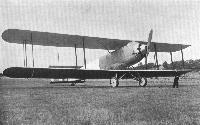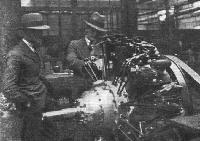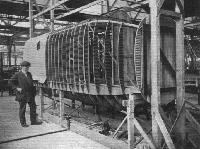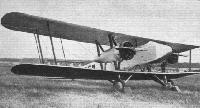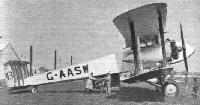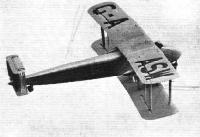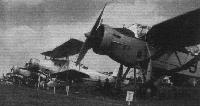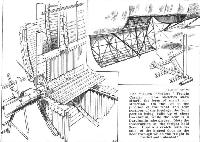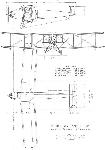
Vickers Type 134 Vellore и Type 212 Vellox
Type 134 Vellore Мк I представлял собой равнокрылый биплан, предназначавшийся для перевозки грузов. На нем был установлен звездообразный двигатель Bristol Jupiter IX мощностью 525 л.с. (391 кВт), а открытая кабина располагалась перед крыльями и вмещала двух человек, размещавшихся рядом. Позади и ниже кабины имелся вместительный грузовой отсек. Vellore I имел размах крыльев 23,16 м, массу 4309 кг и скорость 183 км/ч. Впоследствии самолет оснастили двигателями Armstrong Siddeley Jaguar VI, с которыми он отправился в 1929 году в полет по маршруту Великобритания - Австралия, но после аварийной посадки был поврежден и списан. Обозначение Vellore Mk II не использовалось, но были построены два двухмоторных самолета - Type 172 Vellore Mk III и Type 173 Vellore Mk IV, которые оснащались звездообразными двигателями Bristol Jupiter XIF мощностью 525 л. с. Последним представителем семейства стал Type 212 Vellox, построенный в единственном экземпляре для гражданских воздушных перевозок и вмещавший бортпроводника и 10 пассажиров. Самолет оснащался двумя звездообразными двигателями Bristol Pegasus IM3 мощностью по 600 л. с. и был облетан 23 января 1934 года, после чего его приобрела авиакомпания «Imperial Airways», где он использовался как грузовой.
Описание:
- Vickers Type 134 Vellore и Type 212 Vellox
- Flight, September 1928
THE VICKERS "VELLORE"
Фотографии
-
Flight 1928-06 / Flight
VICKERS "VELLORE": Freight Carrier, with Bristol "Jupiter" Engine. From the pilot's cockpit an excellent view is obtained.
-
Flight 1928-09 / Flight
THE VICKERS "VELLORE" FREIGHT CARRIER: Three-quarter rear view. Note the biplane tail and the four rudders. The man standing next to the machine gives a good idea of the size.
-
Мировая Авиация 249
Регистрационный номер: G-EBYX [3] Самолет Vellore I в первоначальной конфигурации с двигателем Bristol Jupiter.
-
Flight 1929-03 / Flight
NOT A CONJUROR: The man in this photograph is not balancing the Vickers "Vellore" on a stick, but is starting the "Jaguar" by means of a long detachable cranking handle.
-
Flight 1929-03 / Flight
Регистрационный номер: G-EBYX [3] TOWARDS AUSTRALIA: The Vickers "Vellore," with Armstrong-Siddeley geared "Jaguar" engine, on which Moir and Owen are making a fast flight to Australia.
-
Flight 1929-03 / Flight
Регистрационный номер: G-EBYX [3] -
Flight 1929-03 / Flight
For the Australian Flight: Our picture shows Flt.-Lieut. Moir and Pilot-Officer Owen inspecting the Armstrong-Siddeley Geared "Jaguar" engine which will be fitted to the Vickers "Vellore" machine on which they hope shortly to fly to Australia.
-
Flight 1928-09 / Flight
In Course of Construction: This photograph shows the front portion of the fuselage and gives a good idea of the type of metal construction employed.
-
Flight 1928-09 / Flight
The Vickers "Vellore": Photograph of one of the all-metal wings.
-
Flight 1930-07 / Flight
Регистрационный номер: G-AASW [4] Vellore III. AN all-metal biplane of large size and carrying capacity, fitted with two Bristol "Jupiter" engines. The most powerful machine in King's Cup Race. First public appearance.
-
Flight 1930-11 / Flight
Регистрационный номер: G-AASW [4] Vickers Vellore high-speed freight carrier
-
Flight 1930-07 / Flight
Регистрационный номер: G-AASW [4] THE SCRATCH MAN: The Vickers "Vellore III" gets away.
-
Flight 1931-06 / Flight
Регистрационный номер: G-AASW [4] THE HEAVY STUFF: Although a freight carrier, the Vickers "Vellore" (2 "Jupiters") was looped and generally stunted by Mr. Summers at the Brooklands Meeting.
-
Aeroplane Monthly 1974-04 / P.Moss - Wings for the Empire (4)
Регистрационный номер: G-ABKY [4] Vickers Vellox, G-ABKY, at Croydon in April 1936.
-
Aeroplane Monthly 1989-08 / J.Stroud - Wings of Peace
Регистрационный номер: G-ABKY [4] The last of the bulky Vickers transports. This view of the Vellox shows its unusual tail configuration, with biplane tailplanes, no fins but four rudders.
-
Flight 1934-07 / Flight
Регистрационный номер: G-ABKY [4] FOR FREIGHT WORK: Wrightson & Pearse, of Heston, are to use a Vickers "Vellox" (two Pegasus ) on special freight work. The "Vellox" carries a load of 5,300 lb. and has a maximum speed of 160 m.p.h.
-
Aeroplane Monthly 1989-08 / J.Stroud - Wings of Peace
Регистрационный номер: G-ABKY [4] The "Vellox" (two "Pegasus") heavy load carrier;
The Vellox on a test flight. The sole example, G-ABKY, first flew on January 23, 1934. It served briefly with Imperial Airways and crashed at Wallington on August 10, 1936, killing its crew. -
Aeroplane Monthly 1989-08 / J.Stroud - Wings of Peace
The Type 212 Vellox at Croydon during its freighter service with Imperial Airways.
-
Flight 1934-07 / Flight
NIGHT BOMBER AND TRANSPORT TYPES: In the foreground the nose of the Handley Page "Heyford." Flying past is the Vickers "Vellox."
Другие самолёты на фотографии: Handley Page Heyford / H.P.38 / H.P.50 - Великобритания - 1930
-
Flight 1934-06 / Flight
LOOKING DOWN: Visiting machines can be seen parked around the edge of the aerodrome, while in the foreground is the large Vickers "Vellox."
-
Flight 1934-07 / Flight
IN THE LINE: The first machine is the Westland G.P. monoplane. Beyond may be recognised the Fairey G.P. and "Seal" and the Vickers "Vellox."
Другие самолёты на фотографии: Fairey G.4/31 - Великобритания - 1934Fairey Gordon / Seal - Великобритания - 1931Westland PV.7 - Великобритания - 1933
-
Flight 1929-02 / Flight Advertisements
The Vickers "Vellore": A view inside the freight "hold," looking towards the pilot's cockpit.
-
Flight 1928-09 / Flight
The Vickers "Vellore": Sketch showing the type of Duralumin rib used instead of drag struts. This rib also carries the Bristol-Frise aileron hinge.
-
Flight 1928-09 / Flight
The Vickers "Vellore" Freight Carrier: These sketches show clearly the form of metal construction. On the left is the junction of the front and rear portions of the fuselage, the front portion being built up of sheet Duralumin, while the rear is a Duralumin tube girder. Note the construction of the freight hold floor. Inset is a sketch, with details, of the hinged door in the floor through which the freight is loaded and unloaded.
-
Flight 1928-09 / Flight
Vickers "Vellore" Bristol "Jupiter IX" Engine
- Фотографии
